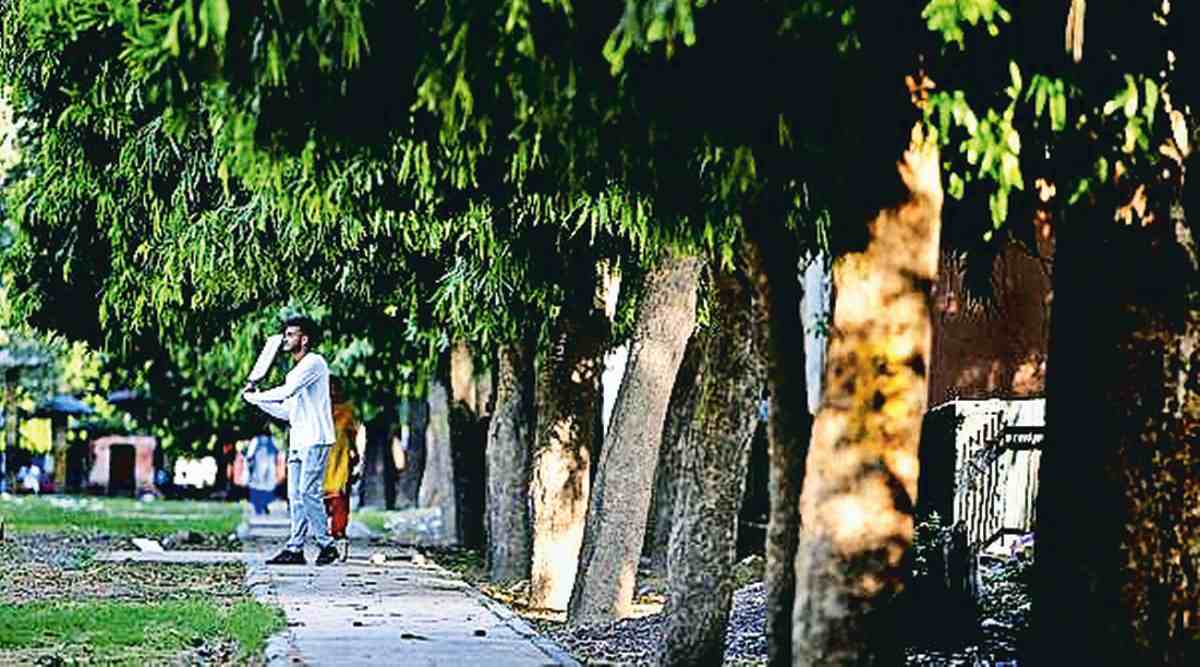 The ISFR considers Delhi's geographical area to be 1,483 sq km. (Express)
The ISFR considers Delhi's geographical area to be 1,483 sq km. (Express) Forest cover in Delhi has reduced by 0.44 sq km between 2019 (195.44 sq km) and 2021 (195 sq km), according to the India State of Forest Report (ISFR), a biennial report released by the Forest Survey of India (FSI) Thursday.
The extent of ‘very dense forest’ (land with tree canopy density of 70% and above) has remained the same at 6.72 sq km. The extent of ‘moderately dense forest’ (land with tree canopy density of 40% and more, but less than 70%) has increased from 56.42 sq km in 2019 to 56.60 sq km, while open forest land (tree canopy density of 10% and more, but less than 40%) has reduced from 132.30 sq km in 2019 to 131.68 sq km in 2021.
Land more than 1 hectare in area, with a tree canopy and density of more than 10%, “including tree orchards, bamboo, palms etc., occurring within the recorded forest and other government lands, private community or institutional lands” is categorised as ‘forest cover’.
Out of the seven major cities, the assessment considered Bengaluru, Ahmedabad, Chennai, Delhi, Hyderabad, Kolkata, Mumbai- Delhi being the only city with patches of ‘very dense’ forest cover.
In the assessment carried out in 2011, Delhi had 174.33 sq km under ‘forest cover’. While the total forest cover has increased since then, the area under ‘very dense’ forest has reduced. It was 6.82 sq km in 2011.
Meanwhile, the extent of ‘trees outside forests’ in Delhi is 283 sq km, higher than that in 2019 (265 sq km). As per the report, this will include trees along linear features such as roads, canals, bunds, and scattered trees.
There has been an increase in terms of ‘tree cover’, which refers to isolated trees and small patches of trees that are less than 1 hectare in area and found outside recorded forest areas. The ‘tree cover’ has increased from 129 sq km in 2019 to 147 sq km.
The ‘Recorded Forest Area’, which is the area recorded as ‘forest’ in government records and comprises of protected or reserved forests, such as the Ridge, covers an area of 103 sq km. However, the extent of ‘very dense forests’ in these recorded forest areas is only around 3.19 sq km.
Experts maintain the report does not provide an accurate picture of the green cover. “It is a pity that the report does not take into account the quality of these forests. Forests are structured communities, like the ones in the city’s biodiversity parks. According to the survey maps, the Ridge is a forest. But they don’t distinguish between Prosopis juliflora (Vilayati Kikar) and native trees,” said Professor C R Babu of the Centre for Environmental Management of Degraded Ecosystems.
Plantations are also considered forests, Prof Babu pointed out: “But a plantation of eucalyptus is not a forest. Forest communities provide a wide range of ecological services including buffering local weather and acting as effective filters for pollutants.”
The forest cover may have declined because of land-use change, since some areas may have been given away for developmental activities, Professor Babu said.
“Ecologically, forests are very different from counting land with trees on it. You may calculate that so much is forest land in the records of the forest department. But that does not give you any sense of the quality of the forest, or how biodiverse it is. Most of the increase we see in Delhi is likely to be the compensatory afforestation areas. An increase in tree cover could mean increase in plantation. But that may not support biodiversity, water recharge functions, or livelihood dependence that forests would have,” Kanchi Kohli, a researcher at the Centre for Policy Research, said.
A senior forest official, who asked not to be named, focussed on the extent of ‘very dense forest’ remaining the same, and ‘open forest’ seeing a marginal reduction in area. “In terms of the green cover in total, forest cover plus tree cover, there has been an increase of 17.5 sq km. For a small State like the NCT, it is a good increment,” he said.
Environment Minister Gopal Rai said green cover has increased from 21.88% to 23.06% of the city’s geographical area in the past two years. The overall green cover is now 342 sq km, which was earlier 324.44 sq km, he said.
The ISFR considers Delhi’s geographical area to be 1483 sq km.
- The Indian Express website has been rated GREEN for its credibility and trustworthiness by Newsguard, a global service that rates news sources for their journalistic standards.

